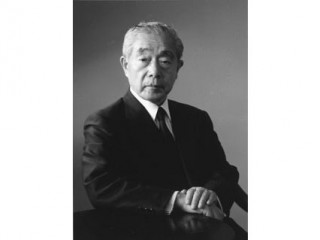
Kenichi Fukui biography
Date of birth : 1918-10-04
Date of death : 1998-01-09
Birthplace : Honshu, Japan
Nationality : Japanese
Category : Science and Technology
Last modified : 2011-09-01
Credited as : Chemist, chemical reactions, Nobel Prize in Chemistry
Kenichi Fukui was a theoretical chemist whose career was devoted to explaining the nature of chemical reactions. His work was distinguished from that of other chemists by its mathematical structure. He especially contributed to bridging the gap between quantum theory, a mathematical theory of the behavior of molecules and atoms, and practical chemistry. He made it easier both to understand and predict the course of chemical reactions, and he shared the 1981 Nobel Prize in chemistry with Roald Hoffmann.
Fukui was born October 4, 1918, in Nara on the island of Honshu, Japan. He was the eldest of three sons born to Chie and Ryokichi Fukui. His father was a merchant and factory manager who played a major role in shaping his son's career; he persuaded Fukui to study chemistry. Fukui had no interest in chemistry during high school and he described in his autobiography, from the Nobel Foundation website, that his father's persuasiveness was the "most decisive occurrence in my educational career." He enrolled at the Department of Industrial Chemistry at Kyoto Imperial University, and he remained associated with that university throughout his life. Fukui graduated from the university in 1941, and he spent most of World War II at a fuel laboratory, performing research on the chemistry of synthetic fuel.
Fukui returned to Kyoto University in 1945, when he was named assistant professor. He received his Ph.D. in engineering in 1948 and was elevated to a full professorship in physical chemistry in 1951. At the beginning of his career, his research interests ranged broadly through the areas of chemical reaction theory, quantum chemistry, and physical chemistry. But during the 1950s, Fukui began theorizing about the role of electron orbitals in molecular reactions. Molecules are groups of atoms held together by electron bonds. Electrons circle the nuclei in what are called orbitals, similar to the orbit of planets around the sun in our solar system. Whenever molecules react with one another, at least one of these electron bonds is broken and altered, forming a new bond and thus changing the molecular structure. At the time Fukui began his work, scientists understood this process only when one bond was changed; the more complex reactions, however, were not understood at all.
During the 1950s, Fukui theorized that the significant elements of this interaction occurred in the highest occupied molecular orbital of one molecule (HOMO) and the lowest unoccupied molecular orbital of another (LUMO). Fukui named these "frontier orbitals." The HOMO has high energy and is willing to lose an electron, and the LUMO has low energy and is thus willing to accept an electron. The resulting bond, according to Fukui, is at an energy level between the two starting points. Over the next decade, Fukui developed and tested his theory using complex mathematical formulas, and he attempted to use it to predict the process of molecular interaction and bonding.
Fukui continued to break new ground in theoretical chemistry through the 1960s. Other chemists began research on these same problems during this period, but Fukui's work was largely neglected. His use of advanced mathematics made his theories difficult for most chemists to understand, and his articles were published in journals that were not widely read in the United States and Europe. In an interview quoted in the New York Times, Fukui also attributed some of his obscurity to resistance from Japanese colleagues: "The Japanese are very conservative when it comes to new theory. But once you get appreciated in the United States or Europe, then after that the appreciation spreads back to Japan."
Two of the chemists who had been working independently of Fukui were Roald Hoffmann of Cornell University and Robert B. Woodward of Harvard, and in 1965 they came to conclusions that were similar to his, though they had arrived there along a different path. Staying away from complex math, these two developed a formula almost as simple as a pictorial representation. Taken together, the work of Fukui and the American team enabled research scientists to predict how reactions would occur and to understand many complexities never before explained. These formulae answered questions about why some reactions between molecules occurred quickly and others slowly, as well as why certain molecules reacted better with some molecules than with others. They removed much of guesswork from this area of chemistry research.
For the advancements in knowledge their work had brought, Fukui and Hoffmann were jointly awarded the 1981 Nobel Prize in chemistry. Woodward, who would probably also have shared in the prize, had died two years before. Fukui was one of the first Japanese to receive the Nobel Prize in any field, and the very first in the area of chemistry. After winning the Nobel Prize, Fukui remained at Kyoto University, and he continued to be active in his field. He continued his research on chemical reactions and expanded his formula to predict the interaction of three or more molecules.
Fukui was elected senior foreign scientist of the American National Science Foundation in 1970. In 1973, he participated in the United States-Japan Eminent Scientist Exchange Program. In 1978 and 1979, he was vice-president of the Chemical Society in Japan, and he served as their president from 1983 to 1984. In 1980, he was made a foreign member of the National Academy of Sciences, and in 1982 he was named President of the Kyoto University of Industrial Arts and Textile Fibers. He was a member of the International Academy of Quantum Molecular Science; the European Academy of Arts, Sciences, and Humanities; and the American Academy of Arts and Sciences. He served as director of the Institute for Fundamental Chemistry from 1988 until his death on January 9, 1998, in Kyoto, Japan.
















